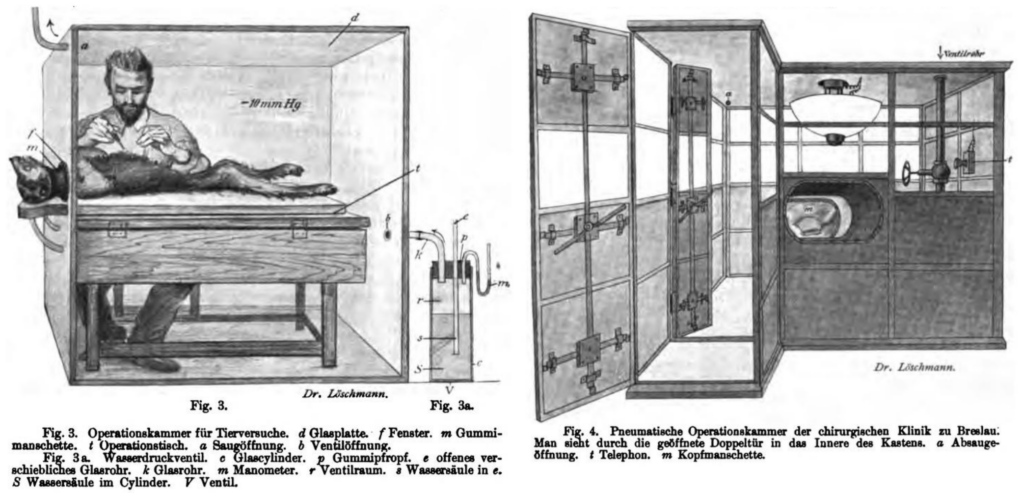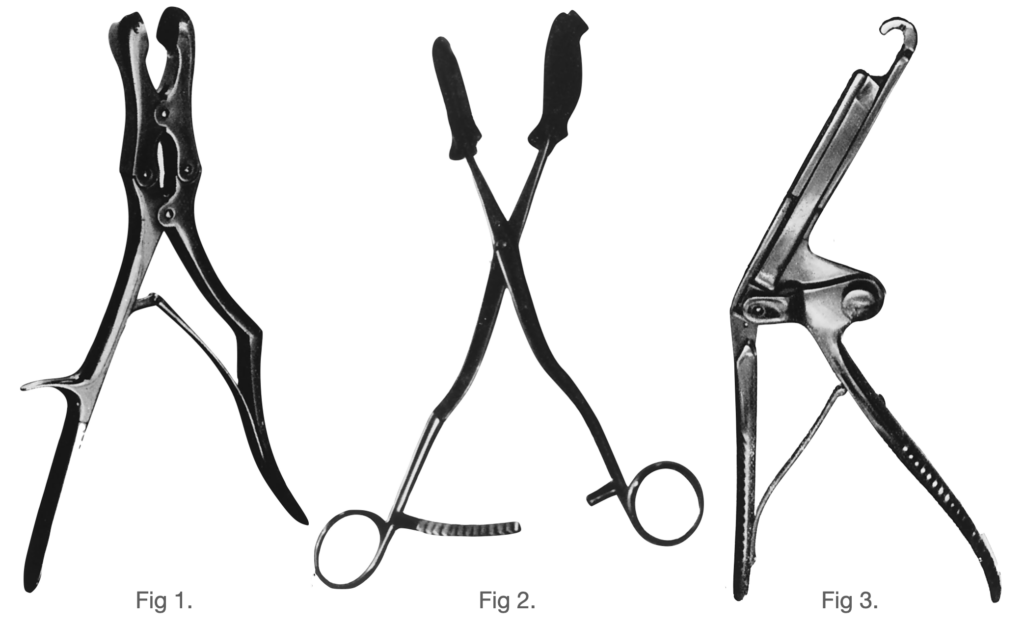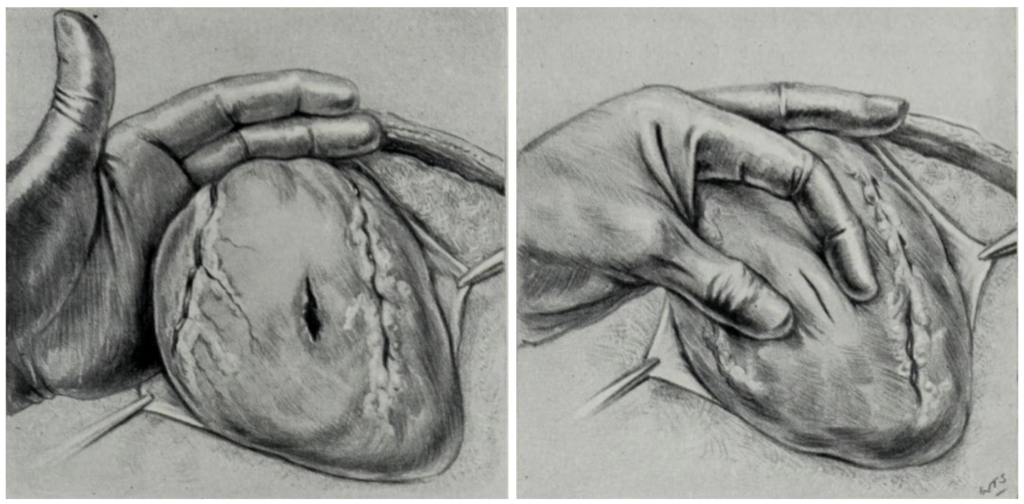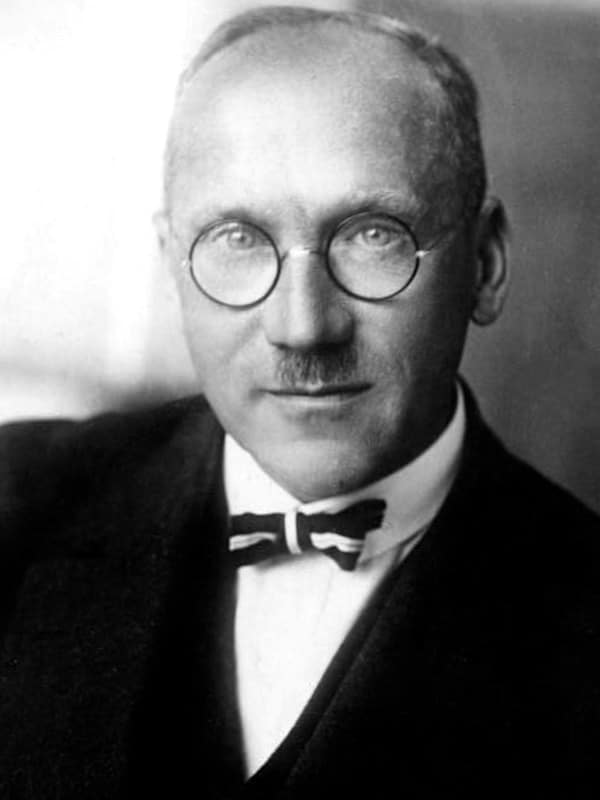Ferdinand Sauerbruch
Ernst Ferdinand Sauerbruch (1875-1951) was a German thoracic surgeon
One of the most formidable surgeons in Europe of the 20th Century, Sauerbruch is considered the father of thoracic surgery who devised a method to access the thoracic cavity and heart during surgery and thus circumnavigate the pneumothorax problem. His invention the Sauerbruch chamber espoused the principle of static negative pressure to eliminate pneumothorax in the open chest but at its core was not a ventilator – it instead allowed him to develop novel techniques for intrathoracic operations including:
– Paravertebral thoracoplasty for the surgical treatment of tuberculosis
– Conceived the ‘Sauerbruch grip’ for haemostasis during suturing of cardiac lacerations
– Resection of the pericardium for treatment of constrictive pericarditis
– Lung resection as surgical treatment of bronchiectasis and suppurative lung infections
– Pioneered work for operative techniques involving the oesophagus and was the first to resect and re-anastomose the oesophagus for treatment of a cancer
Notwithstanding his contributions to thoracic surgery, the method of negative pressure did lay the foundation for negative pressure ventilation that followed and perhaps found its greatest revival in Drinker’s Iron lung during the Polio epidemic. His other significant achievement was his work in pioneering prosthetic limbs for war veteran amputees.
Sauerbruch was the pinnacle for surgery at the time for whom swathes of medical doctors and aristocracy flocked to him for advice; alas he was not immune to the afflictions of old age, illness and incompetence which forced him to retire and marred his once great reputation.
Biography
- Born on July 3, 1875 in Barmen Germany; his father died when he was 2yo from tuberculosis leaving Sauerbruch and his mother destitute. They were taken in by Sauerbruch’s maternal grandfather, a retired shoemaker who supported much of Sauerbruch’s education
- Devises his first invention – press-studs for boots as a less tedious alternative to buttons and laces after witnessing his mother and Aunt laboriously buttoning and unbuttoning customer boots
- 1895 – studies natural sciences in Marburg
- 1901 – graduates in medicine from the University of Leipzig. Initially works as a country doctor before moving to the surgical department at the Protestant Deaconess Hospital of Kassel as an assistant. He is fired after he performs emergency surgery on a patient on a Sunday when he calls for help in the OR and disturbs the religious service.
- 1902 – doctorate under Heinrich Curschmann with thesis: A contribution to the metabolism of lime and phosphoric acid in infantile osteomalacia. First assistant physician at Erfurt Hospital. Develops an interest in thoracic surgery arises after he performs a post mortem on a patient gored by a bull causing a pneumothorax; resigns from his post because of his desire to further his scientific research in the prevention of pneumothorax
- 1903 – works briefly at Berlin-Moabit hospital before moving to the Surgical University Hospital in Breslau where he works under surgical colleague Jan Mikulicz-Radecki (1850-1905); starts work on a method to allow for access to the thoracic cavity during surgery without causing pneumothorax and devises the negative pressure chamber – the Sauerbruch chamber
- 1904 – following 78 successful operations on dogs using his invention, Sauerbruch presents to the 33rd Congress of the German Surgical Society to great reception. Mikulicz performs the first successful operation whilst in the negative pressure chamber on a patient with breast tumor. Sauerbruch subsequently performs his first and the second successful case using his device on a patient with metastatic cancer of the ribs.
- 1907 – conceives the ‘Sauerbruch grip’
- 1908 – demonstrates his negative pressure chamber to an audience in New York and other cities across the United States; receives a professorship of surgery
- 1910 – chief of surgery, University of Zurich; becomes the first surgeon to resect the phrenic nerve and produce artificial paralysis of the diaphragm; develops techniques for transdiaphragmatic laparotomy
- 1912 – performs a pulmonary embolectomy; Receives Order of the Red Eagle from Wilhelm II, Kaiser of Germany
- 1913 – first surgeon to resect the pericardium for constrictive pericarditis; the operation is a success and the patient goes on to survive the next 11 years
- 1914-15 consulting Staff-Surgeon-Major to the Fifteenth Army Corps of the German Army in WWI; His experiences in war casualties and amputations leads Sauerbruch to design artificial limbs and together with Prof Stodola of the Zurich Technical College develops the ‘Sauerbruch-Stodola hand’
- 1916 – publishes silent film ‘Die willkürlich bewegbare künstliche Hand‘ of the Sauerbruch hand
- 1918 – chief of surgery, University of Munich; surgeon-general of the Bavarian Army
- 1927 – chair of Surgery at Berlin University; director of the Surgical Clinic at Charité Hospital
- 1931 – operates incidentally on and successfully treats a cardiac aneurysm becoming the first in the world to do so; the case patient had been misdiagnosed as having a mediastinal cyst. Incision results in high pressure bleeding with Sauerbruch suturing the defect and effectively excluding the aneurysm
- 1936 – publishes book titled ‘Pain, Its meaning and Significance’ where he explores the medical and philosophical aspects of pain
- 1937 – awarded the German National prize for his contributions to medicine
- 1942 – receives the Knight’s Cross of the War Merit Cross for his services to the Army
- 1949 – Sauerbruch is forced to resign all surgical positions following years of unsafe operating and increasing patient morbidity and mortality secondary to dementia
- 1950 – begins work at a private clinic run by Dr Jungbluth at Grunewald, Berlin. This lasts only for a few months after Jungbluth is confronted with the reality of Sauerbruchs’ dementia whom during a sclerotic episode, walks out of an operating room in anger. Sauerbruch later that year is invited to present at a medical conference where his speech becomes increasingly incoherent; his medical condition thereafter becomes public knowledge
- Although barred from hospitals and clinics, Sauerbruch sets up consulting rooms in his lounge room where he continues to see patients devoted to him and his once renown presence in the medical field. He begins operating from his lounge room with inadequate instruments and questionable sterility resulting in high rates of post-operative complications. Warnings from the Board of Health do little to detract Sauerbruch from his work
- 1951 – performs his final operation attempting to remove a metastatic tumour of the neck in an unanaesthetised 41yo who dies 6mths later from post-operative infection
- Died on July 2, 1951 aged 75 following intracerebral haemorrhage
- 1954 – Film: Sauerbruch – Das war mein Leben biography of Sauerbruch which were ghostwritten by Hans Rudolf Berndorff and published in the German magazine Revue shortly before the films release on July 13, 1954.
Medical Eponyms
Sauerbruch Chamber
A change occurs when positive pressure enters the pleural cavity, that because of its own elasticity the lung collapses to a smaller volume…conversely, the lower the pressure the less effect of elasticity…if we maintained the physiological differential pressure during surgical opening of the chest, the lung would remain expanded…by this method we could eliminate the dangers of pneumothorax…
Sauerbruch 1904

The initial prototype consisted of a glass container with two apertures – one from which air was sucked out via an air-pump with a valve and the other to allow for access of the surgeon’s arms. Sauerbruchs’ first experiments were in dogs and the animal was placed in the container with rubber ringed outlets to effect a seal for the animals’ limbs.
I first constructed an exceedingly primitive apparatus. An open glass cylinder was closed off at both ends by sheets of rubberized cardboard. At one end three holes were made in the cardboard…The experimental animal was placed through the larger holes, so that its head protruded from one side, its lower body and hind limbs from the other, while its thorax and upper abdomen remained within the cylinder… an assistant connected a drainage tubing to the cylinder through which air was withdrawn until negative pressure developed…about the level of -10 mm…I opened the thorax; the lung did not collapse, and the animal’s respirations continued undisturbed…
Sauerbruch 1904
He was able to perform a successful thoracotomy without pneumothorax although when he presented his work to Professor von Mikulicz, a leak in the air chamber caused the experiment to fail and Sauerbruch was expelled from the hospital for ‘cheating.’ (later revoked following a successful demonstration)
The next design was a larger pressure chamber that could accommodate both the surgeon and the patient. It measured approximately 2.5×2.25×2.5m and incorporated an electric driven suction pump which served as both an oxygen and pressure pump. A second manually operated pump could be used in cases where electrical failure occurred. Pressures of 1/10th bar were generated before thoracic surgery could begin. Increasing successful thoracic operations made possible by the Sauerbruch chamber, saw Sauerbruch also develop multiple surgical tools that bear his name.

Fig 1: Sauerbruch’s modification of the giant Luer forceps.
Fig 2: Sauerbruch’s lung-holding forceps with rubber-covered jaws.
Fig 3: Sauerbruch’s guillotine for section of the first rib.
The pneumatic chamber is a room with a volume of 14 cubic meters….foundations are of heavy sheet iron…above 1.3m the wall is made of plate glass… a mixture of putty and glue…achieved a satisfactory airtight closure…the opening for the patient’s head…is oval in shape…a double rubber collar is secured within it…“evacuation of air is accomplished by a suction pump which at its top speed can evacuate 300litres per minute….(the pump) is connected to the interior of the chamber through two valve systems…can all be regulated from the interior of the chamber….
In order to maintain isolation of the chamber during an operation, outside this door is a lock-cubicle….closed off by a second air-tight door. The bolting of both doors onto ribber gaskets…seals us within
Sauerbruch 1904
Almost at the same time as Sauerbruch published his innovation, Dr Ludolph Brauer, a professor of internal medicine introduced his positive pressure cabinet, an ‘inversion of the Sauerbruch method’ as described by Mikulicz in an editorial footnote to Brauer’s paper and whom gave equal credit to Brauer’s invention
The concept of the positive pressure method occurred to Herr Professor Brauer entirely independently…there is no doubt that if positive pressure management proves useful not only in animal experiments but also in patients, it will mean an important technical simplification of the entire method
von Mikulicz 1904
The advent of the endotracheal tube saw positive pressure ventilation replace negative pressure ventilation; indeed the last stand of the Sauerbruch method was probably during the polio era with Drinker’s iron lung (1929) and the Emerson lung (1931)
Sauerbruch grip
Where bleeding is so profuse that the wound cannot be located, it is sometimes necessary to resort to the procedure of Sauerbruch. The technique involves compression of the base of the heart and venae cava by the ring and middle fingers; then compression of the right heart between the thumb and index finger. This caused inflow occlusion of the heart and allowed for ease for suturing of cardiac lacerations

Sauerbruch hand (SauerBruch-Stodola hand)
Hand prosthesis controlled and powered directly from surgically prepared muscles of the residual limb
Devised and built in 1915 by Sauerbruch in collaboration with Aurel Stodola (1859-1942), a famous Slovak physicist, and professor of mechanics at the Federal Polytechnical School in Zürich
Die willkürlich bewegbare künstliche Hand: Patient with double-sided forearm amputation and tunneling of muscle after Sauerbruch where flexor and extensor of the forearm stump are modelled into a skin channel. This treatment enables the patient to transmit his muscle power to the prosthesis. The film documents the daily routine of the patient putting on and off his prosthesis.
Major Publications
- Sauerbruch F. Beitrag zum Stoffwechsel des Kalks und der Phosphorsäure bei infantiler Osteomalazie. Inaug.-Diss. Leipzig 1902.
- Sauerbruch F. Ueber die physiologischen und physikalischen Grundlagen bei intrathorakalen Eingriffen in meiner pneumatischen Operationskammer. Archiv für klinische Chirurgie 1904; 73: 977-987
- Sauerbruch F. Zur Pathologie des offenen Pneumothorax und die Grundlagen meines Verfahrens zu seiner Ausschaltung. Mitteilungen aus den Grenzgebieten der Medizin und Chirurgie. 1904; 13: 399-482
- Sauerbruch F. Über die Ausschaltung der schädlichen Wirkung des Pneumothorax bei intrathorakalen Operationen. Zentralblatt für Chirurgie 1904; 31: 146-54.
- Sauerbruch F. Experimentelles zur Chirurgie des Brustteils der Speiseröhre. 1905
- Sauerbruch F, Schumacher ED. Technik der Thoraxchirurgie. 1911
- Sauerbruch F. Die willkürlich bewegbare künstliche Hand: Eine Anleitung für Chirurgen und Techniker. 1916 [Sauerbruch Hand]
- Sauerbruch F. Die Chirurgie der brustorgane. 1920
- Sauerbruch F. Chirurgische Operationslehre. 1933
- Sauerbruch F. Wesen und Bedeutung des Schmerzes. 1936 [Pain; its meaning and significance]
- Sauerbruch F, O’Shaughnessy LF. Thoracic surgery;. – NLM Catalog – NCBI (nih.gov). 1937 [revised and abridged edition of Sauerbruch’s Die Chirurgie der brustorgane]
- Sauerbruch F. Advances in modern surgery. 1937
- Sauerbruch F. Die willkürlich bewegbare künstliche Hand. Reichsanstalt für Film und Bild in Wissenschaft und Unterricht (RWU). 1937 [doi.org/10.3203/IWF/C-183]
- Sauerbruch F. Das war mein Leben. Verlegt bei Kindler. München, 1951
Sauerbruch The Person
Sauerbruch was a devoted surgeon and in all sense of the phrase ‘married to his work.’ His commitment to his patients and his meticulous care won their confidences and saw him rise to eminence where persons of aristocracy, business and politics clambered to seek his advice. Among those prominent names included King Constantine of Greece, Paul von Hindenburg, the President of the Reich and General Ludendorff, a former general of the Royal Prussian Army. Not one to be intimidated by status, Sauerbruch was known to demand exorbitant fees from the wealthy whilst showing compassion to the poor.
Sauerbruch was a strict disciplinarian and incredibly short tempered. The standards to which he held himself to, he expected of others – in fact, Sauerbruch had an unwritten law of celibacy at his clinic, believing that one should be dedicated to work and the hospital and dismissing assistants who disobeyed this rule. Indeed, Sauerbruch himself spent little time at home, saw his children infrequently and later divorced and remarried shortly thereafter
Controversies
Sauerbruch’s position towards the Nazi government is a source of controversy. Although never a member of the NSDAP, he was a known supporter of its principles and occupied a position as head of the medical section of the Reich Research Council where he approved ‘research’ on prisoners in concentrations camps. He was also the recipient for the German National Prize for Arts and Sciences, a short-lived award created by Hitler as a counterpart to the Nobel prize. Other honors bestowed upon him by the National Socialists was the position of Surgeon general in 1942 and the Knight’s Cross of the War Merit Cross by Hitler’s personal physician Karl Brandt.
On the contrary, Sauerbruch was a member of the Wednesday’ s Society, a group known for its criticisms of the NSDAP and of whom some were involved in the attempted assassination of Hitler. Sauerbruch was also a supporter of persecuted Jews and was one of the few University professors to advocate against the Euthanasia Program T4 – a Nazi effort to kill or ‘euthanise’ the physically or mentally disabled, incurably ill and elderly people.
Sauerbruch’s activities were called into review by the Allies in 1949 at a denazification tribunal however he was found not guilty due to lack of evidence.
References
Biography
- Sauerbruch – Das war mein Leben, Corona Filmproduktion, Bavaria Film.
- Obituary. E.F. Sauerbruch. Br Med J. 1951 Jul 14; 2(4723): 122-123.
- Editorial. Ferdinand Sauerbruch (1875-1951) – thoracic surgeon. JAMA. 1964; 190(2): 152-153
- Youngson RM. The demented surgeon is operating. In: Medical Curiosities. 1997: 188-196
- Davies MK, Hollman A. Ferdinand Sauerbruch (1875-1951). Heart. 1997 Apr;77(4):301.
- Kötting SE, Greschus S. Ferdinand Sauerbruch (1875-1951). J Invest Surg. 1999 Jan-Feb;12(1):1-2
- Cherian SM, Nicks R, Lord RS. Ernst Ferdinand Sauerbruch: rise and fall of the pioneer of thoracic surgery. World J Surg. 2001 Aug;25(8):1012-20
- Dewey M, Schagen U, Eckart WU, Schönenberger E. Ernst Ferdinand Sauerbruch and his ambiguous role in the period of National Socialism. Ann Surg. 2006 Aug;244(2):315-21
- Hansson N, Schagen U. The Limit of a strong Lobby: Why did August Bier and Ferdinand Sauerbruch never receive the Nobel Prize? Int J Surg. 2014;12(9):998-1002
- Geißler S. Ferdinand Sauerbruch 1875-1951. Lebendiges Museum online 2019
- Slingerland A, Lacquet LKMH. Ferdinand Sauerbruch, father of thoracic surgery. Hektoen International: J.medical humanities. 2020
- Bibliography. Sauerbach, Ferdinand. WorldCat Identities
Eponymous terms
- Brauer L. Die Ausschaltung der Pneumothoraxfolgen mit Hilfe des Ueberdruckverfahrens. Mitteilungen aus den Grenzgebieten der Medizin und Chirurgie. 1904; 13: 483-500.
- von Mikulicz J. Editorial footnote to the paper of Brauer. 1904; 13: 483
- Bailey H. Emergency surgery 4e. 1940: 494-495
- Meyer JA. Unterdruck and Uberdruck, 1904. Ann Thorac Surg. 1989 Jun;47(6):933-8.
[cite]
Emergency registrar at Sir Charles Gairdner Hospital, Perth


